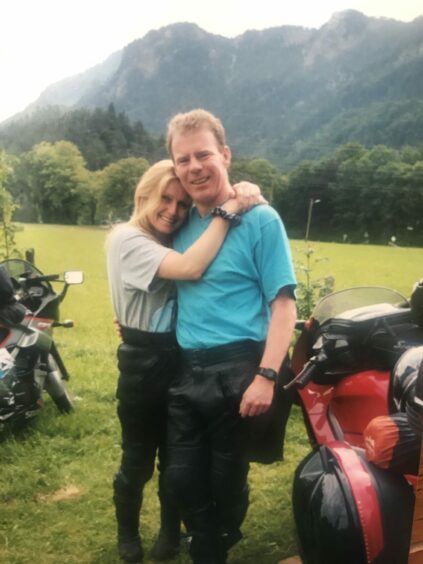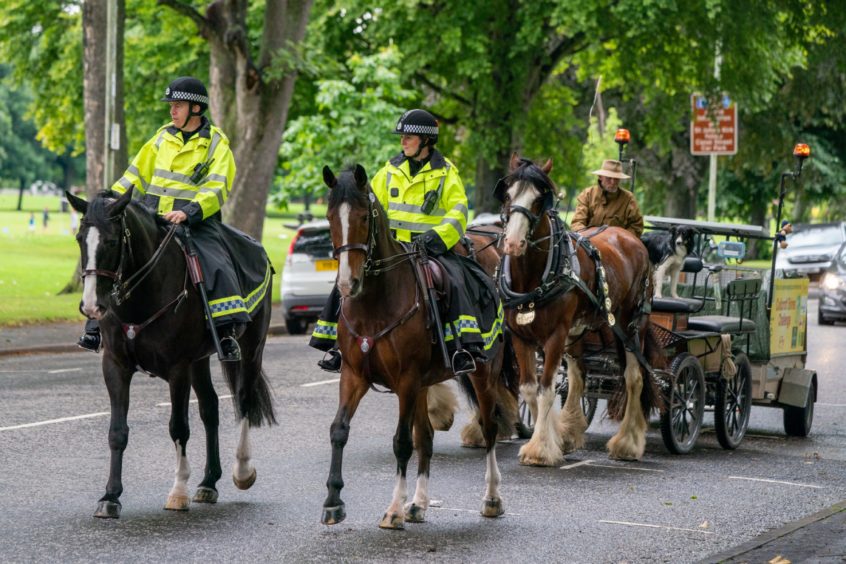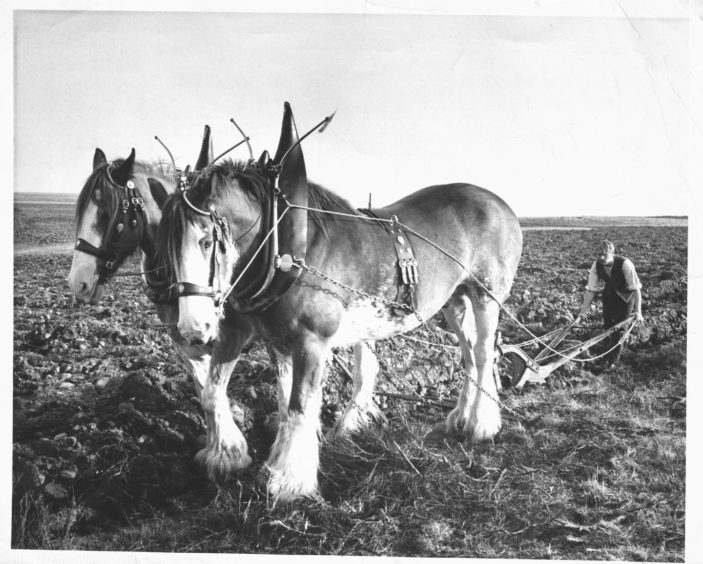Jamie Alcock is driving his Shire horses from Gloucestershire to Elgin in memory of his policeman brother who died while protecting the royal family at Balmoral. Gayle Ritchie caught up with Jamie in Perth.
Two magnificent Shire horses pulling a carriage, a cute collie dog and a farmer with a twinkle in his eye.
It’s a spectacle that many people across the UK are enjoying as Jamie Alcock drives his heavy horses Millie and William an incredible 650 miles up the country in memory of his brother.
Having left his farm in Gloucestershire on June 5, Jamie plans to finish his journey in Elgin on August 21. He’s in Perth when I catch up with him, having just tipped the halfway mark at 390 miles.
He’s tired mentally and physically, as are the horses. Boo Boo the dog is the only one still full of beans.
Jamie, 55, tells me the trip, thus far, has been full of emotion and excitement, and, as I discover later, the odd bump and scrape.
His mission – which he’s calling the Coldcroft Shires Challenge, after his farm – is to raise funds for two charities close to his heart – The Fire Fighters Charity and Police Care UK. They helped support his brother PC John Alcock after he was involved in a horrific car accident.
An officer with Grampian Police, stationed at Elgin, he was a passenger in a marked patrol car when it was hit head-on by a tourist as he was making his way to guard the royal family at Balmoral in 2003.
John suffered a devastating head injury and never regained consciousness.
Two years after the accident, he returned home to a hospital room created at the back of his house.
He received round-the-clock nursing care.
Sadly, John passed away in 2017 aged 54 and was buried with full Police honours at Garmouth, north of Fochabers.
“My brother was in a coma for 14 years before passing away,” laments Jamie. “In my heart, I lost him in 2003.
“The idea has always been at the back of my mind that I wanted to do something to pay my respects, to him and the charities that helped.
“The way they responded to John’s situation, how they looked after him and his family was incredible.
“And I often think about the fact that a firefighter was probably the last person to speak to my brother as he was cut out of the vehicle, before he became unconscious.”
In February, Jamie had a moment of inspiration. Having been cooped up on his farm since January 2020 thanks to Covid-19, he decided the summer of 2021 would be the right time to do his epic fundraising challenge.
There would be plenty of daylight should anything go wrong, whether a puncture or a horse throwing a shoe.
GENTLE GIANTS
The largest horse breed in the world, Shires are also known as “gentle giants”.
As well as being stunningly beautiful, with their flowing manes, thick feathers and soft eyes, they are strong and muscular, with an enormous pulling power.
Nevertheless, taking on a 650-mile journey – even while wearing custom-made “journey shoes” – is no mean feat.
It was only when Jamie stopped at the Scottish Police College in Tulliallan, Kincardine, that he realised how travel-weary he and the horses were. He was very grateful to be offered bed and board there for six nights while the horses got plenty of grazing.
However, his time at Tulliallan was deeply emotional. It was the first time he had visited the memorial with his brother’s name on it.
“I found that quite difficult,” reflects Jamie. “I’ve found on the course of this journey that memories of my brother are much closer to the surface than they have been for years. It’s the little memories that pop up – obscure moments of time spent together.”
CLOCKING UP THE MILES
As Jamie, Boo Boo and the horses journey north, they are averaging 20 miles a day.
It was around 27C when they visited The Kelpies, the largest equine sculptures in the world, near Falkirk.
“There’s a great deal of steel and stone there and that reflected a lot of heat,” says Jamie.
“I made sure to give the horses plenty of water and electrolytes to replace what they were sweating out. There’s a big risk of dehydration.”
Having never set eyes on The Kelpies before, Jamie was completely blown away.
“There’s something about those statues that’s difficult to put into words,” he says.
“They’ve got presence. I’m not normally moved by the visual arts but they’ve captured something special.”
Other highlights along the way have included the world-famous Beamish open air museum in County Durham, climbing up into the Lammermuir Hills, being escorted by the Mounties from Holyrood Park in Edinburgh to Murrayfield, getting a tour of Duns Castle in Berwickshire, and exploring the grounds of Tulliallan.
Jamie, who lived for a spell in Rothienorman in Aberdeenshire in the late 70s and early 80s while his RAF fighter pilot dad was stationed nearby, is hugely excited about getting to the Highlands, or the “wilderness” as he calls it.
“That’s what excites me most, over and above cities,” he adds. “Get me to the wilderness any day!
“But we’re just travelling gently and taking it mile by mile. The carriage and trailer weigh about a tonne, but the horses are incredibly strong. They could pull 40 tonnes in an emergency.”
The horses’ welfare comes before everything; Jamie plans where he’s staying around where they can graze and have good access to water. Accommodation so far has comprised of caravans, farms, holiday cottages, fire stations, equestrian centres, and in his tent.
When the group reached the outskirts of Perth, they were escorted by mounted police to South Inch where they met three fire and rescue crews and were presented by a painting by Abernyte-based artist and animal behaviourist Abbie Withers.
Abbie, like so many people, has been following Jamie’s progress on social media and become a huge fan. She was inspired to paint a portrait of the horses after seeing a striking photo of them online.
“They’re such beautiful animals and I’m so impressed by what Jamie’s doing that I wanted to help,” she says.
“It sounds silly but I was trembling before I met him! He’s such a lovely man and it was a real honour.”
The painting will be auctioned off to raise money, as will a selection of Mille and William’s used shoes.
While a charity bucket and online donations page have also elicited great generosity from inspired members of the public, Jamie is inviting well-wishers carriage rides in exchange for donations.
“My target is £30,000 but I’d love to smash that,” he muses.
“It’s a difficult time for the charities. They’ve not had opportunities to fundraise during lockdown.
“But people are being so generous, offering us places to stay, coming out to meet us with home-baking, showing us around their villages and giving us a wonderful, warm welcome wherever we go.
“With the hills of the Highlands ahead of us, as we head north to Aviemore, Grantown-on-Spey, and ultimately Elgin, it’s going to be tough, but it’s great to have this level of support and know so many people are behind us.”
ACCIDENT
The plan to head to Pitlochry and Blair Castle, where they’ll stay in the stunning grounds, has had to be put on hold after Jamie had a “wee accident”.
He thinks something spooked the horses while they were on the ground together although he has no idea exactly what happened and no memory of it.
He woke up after five minutes of unconsciousness and was taken by ambulance to Ninewells Hospital in Dundee, with 11 fractured ribs, hairline fractures in four spinal bones, a collapsed lung and a hairline-fractured scapula.
“The consultants are relatively happy with me and once we get my lung reinflated, I’ll be back on the road again,” he insists.
“We still plan to arrival in Elgin on August 21. For any more details, ask Boo Boo!”
When they do get within reach of Elgin, Jamie will be accompanied by one of his brother’s sons. There will be a finale bash in Cooper Park, with details yet to be confirmed.
PASSION
Jamie has adored Shire horses since he was a young boy but it wasn’t until he became a farmer a few years ago that he acquired some.
“I spent a lot of my working life dry stane walling but I’d always had this dream of being a farmer,” he explains.
“When my wife Katie and I got a farm at Coldcroft in Gloucestershire, I decided we needed some Shire horses to work on it.
“We’ve got three – Millie, Morse and William who is the biggest at 18.1hh and is also my riding horse. The horses move heavy stuff around, help with hay-making, furrowing, muck-spreading and harrowing.”
Jamie has high hopes for two-year-old Morse, expecting him to grow to a similar size to William, and regarding him very much part of Coldcroft Shires’ future.
The farm offers Shire horse experiences, including carriage rides and hands-on training. Visitors can learn how to harness working heavy horses and how to long-rein using traditional farming horse-drawn equipment.
HEAVY HORSES
As Jamie Alcock’s Shire horses wend their way through lowland Scotland they will not know that they are crossing the heartland of their cousins, the Clydesdales, says former Courier agriculture editor Ewan Pate.
At the beginning of the 20th Century an estimated 140,000 draught horses were employed on Scottish farms.
They were nearly all Clydesdales and could trace their ancestry back to a couple of Flemish stallions which were crossed with smaller native horses to provide a powerful animal with the stamina to last a full day at the plough.
In these early days Shire blood was introduced judiciously as the Clydesdale became a famous breed in its own right. Characteristically it had strength and grace in an animal weighing just short of a tonne.
The need for draught horses emerged with the enclosure of farms at the beginning of the 19th Century. By then the old practice of a team of oxen pulling clumsy wooden plough with half a dozen attendants belonged to a bygone age. The modern farmer instead used a light steel plough pulled by a pair of horses by only one man.
A highly efficient system soon emerged based on one pair of horses for 80 acres of arable land. Thus, a 240 acre farm needed three pairs in the stable, a 320 acre farm needed four pairs. The unmarried horsemen were housed in a bothy close by.
A pair of horses could plough an acre a day in a day broken into a morning “yoking” from 7am to 11.30am and an afternoon “yoking” from 1pm to 5pm.
The one-and-a-half hour break in the middle of the day allowed time to rest and feed. Horses needed a prodigious supply of oats and hay during the busy seasons of spring and harvest.
The horse system only worked because farms were well-staffed and run with military discipline.
The first cracks appeared in the First World War when vast numbers of horses were requisitioned for service on the Western Front. Few returned.
By the end of the Second World War the supremacy of the tractor was more or less complete and by the mid-1950s the stables were empty.
Farmers did not miss having to grow acres of oats and hay just to feed the horses and most of the horsemen made the transition to tractors easily enough but nonetheless it was the passing of an era which had lasted 150 years.
Fortunately however, the noble Clydesdale breed survives here and around the world. Nowadays they are ridden, driven or just kept as companions.
Some even become drum horses with the swankiest of military mounted bands but largely their days of farm work are over.
- To make a donation to Jamie’s Coldcroft Shires Challenge, see the Coldcroft Shires Facebook page or Shire Horse Challenge at uk.virginmoneygiving.com
























